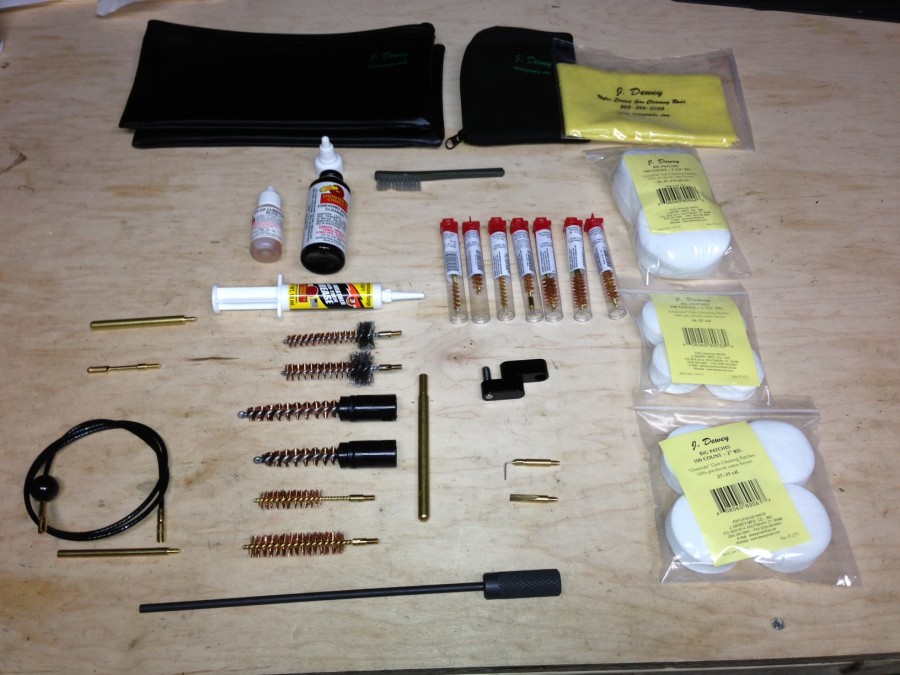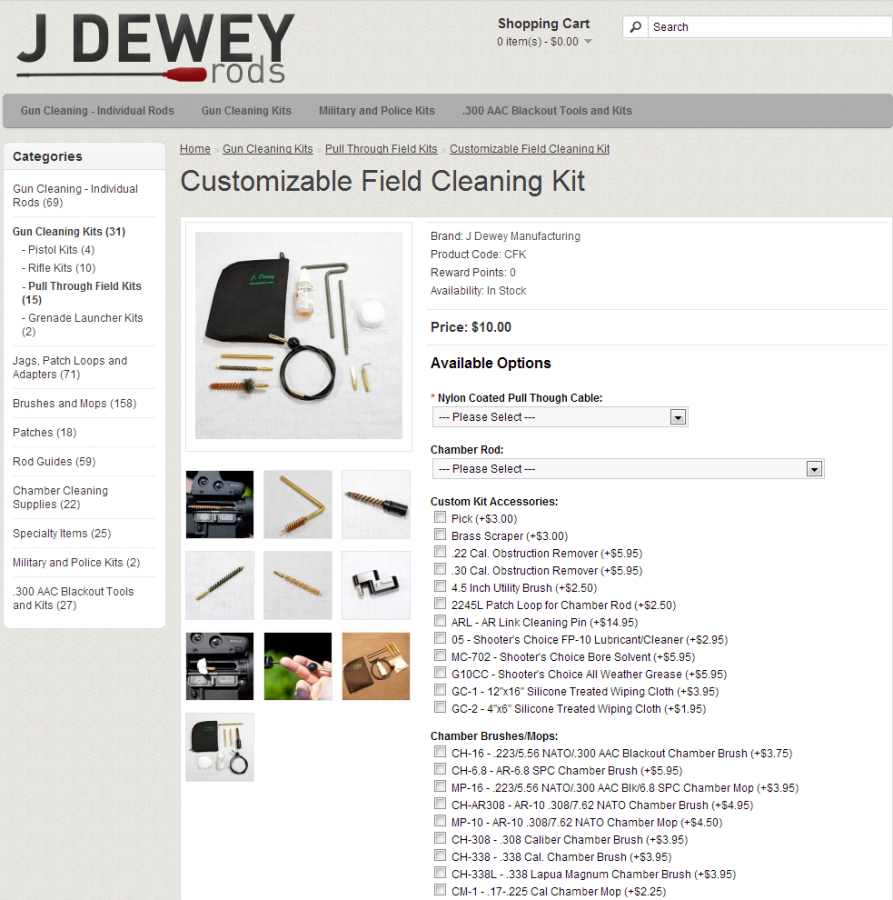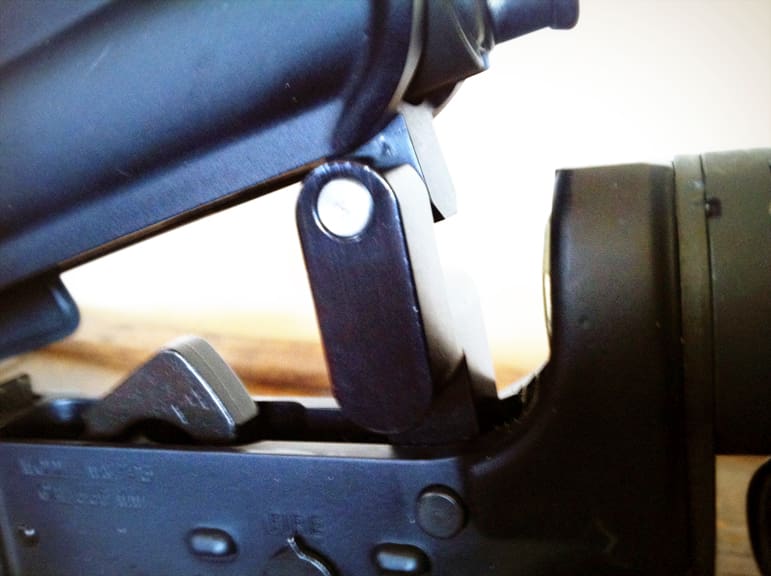While I was working on my review of J. Dewey’s .338 Lapua Magnum Bore Guide and Cleaning Tools, I had a couple of back and forth exchanges with Ken, who as near as I can figure, is Dewey’s PR, Marketing, Web Programming and general do-everything guy. As we were talking, we got around to the subject of their field cleaning kits. While Dewey is definitely well known as a maker of fine gun cleaning tools for the shop, the fact is their field cleaning tools are also well-respected by folks who know a thing or two about shooting . . .
It’s no secret that the folks here at TTAG like the J. Dewey line of products. Ryan Finn heaped praise on their Complete AR cleaning kit a year or so ago. I sure liked what I saw of the .338 Lapua Magnum kit and based on the comments for both of those reviews, our readers are fans of J. Dewey products, too. Ken suggested that I take a look at their line of pull-through field kits and give them some feedback. Well, I bet Ken is sorry he asked, ‘cause I made a whole lot of work for him.
You see, my problem is that while perusing the list, I just couldn’t settle on one kit. I own a range of guns from pistols to rifles in various calibers, sizes, and configurations and every one of the field kits on offer were very specific to certain types of firearms. You could buy one that would cover .22 – .30 rifles, a different one for AR-15s, another for black powder and shotgun, one for .308, one for 6.8mm, one for M14/M1A rifles, etc.
My problem, as I explained to Ken, was that when I head to the range it’s usually with a mix of pistols, rifles, and shotguns. I never know what ranges are going to be available until I get there, so I bring a selection of guns along. I could certainly order multiple cleaning kits, but aside from the extra cost, they’d come with a fair amount of redundancy. For example, I really only need one pull-through cable (well one for .22 and one for .30) to handle most of the rifles and pistols I own. But if I bought four or five kits, I’d be paying for stuff I don’t need.
My suggestion to Ken was to consider doing for the pull through cleaning kits what J. Dewey does for their fixed rod kits – provide the bare essentials and let the customer add tools and accessories to customize the kit to their needs. Frankly, I figured that what Ken would do would be to throw a selection of tools in a case and ship it to me and I’d do an overall review of the pull-through field kits without focusing on any specific one. N’uh uh.
Instead, Ken told me that he loved the idea of a customizable field kit and to give him a week or so to get it coded. That was on a Friday. On Monday morning there was an email in my inbox from Ken letting me know he had one ready for me to look at. Well, much to my delight, Ken had pretty much done exactly what he and I had talked about. The kit began with the base pull-through rod and the customer could then choose exactly the added tools that were needed to create the ideal custom cleaning kit for their personal assortment of guns.
A bit of tweaking was done as I ran through a couple of test builds – Ken identified incompatible components and made the necessary corrections to the product page. There was also the minor matter of a $2,300 chamber brush. I told Ken that while I’m sure it’s a helluva nice brush, I’d probably try to source one a bit cheaper somewhere else. That decimal problem was quickly fixed and now J. Dewey now has the new product page ready to go for your ordering pleasure.
For some people, the ability to clean your rifle in the field is simply not all that important. Folks like that are back home every night and can clean their guns in the comfort of their home. Other folks simply don’t clean that religiously at all, only hitting a gun every second or third outing. On the other hand, if you are out on a multi-day hunting trip or are a military operator patrolling far from base, you’re going to want to be able to maintain your guns in the field. A hunter wants to make sure that when the critical opportunity arises, his gun will function. As for the operator, a malfunction can mean the difference between life and death.
Many of us, though, need to re-think our priorities. Even if you have the luxury of being able to clean at home, there’s something to be said for getting the heavy stuff off while in the field. There are plenty of times that I’ve arrived home, tossed the guns in the safe and promptly forgotten to clean them. Doing a reasonably quick and efficient job in the field is always a good idea, especially if you’re shooting in poor conditions that might include wind-blown sand, dust, rain or snow. You’ll also want to clean your gun ASAP if shooting corrosive ammo.
I’ve used field cleaning kits before and own one from that other company that ships their kits in round containers. The selection of tools is competent, but when compared to the Dewey stuff, you can see why professional soldiers use Dewey gear.
The first thing you notice is the cleaning cable itself. It has two ends – a patch holder and a socket for another tool. It also makes a departure from other cable cleaning kits you may have used before — you’ll notice that there is no T-handle. Instead, the Dewey cable features a ball that’s permanently attached to the cable and used to pull the cable through the bore.
This design has two consequences. First, there’s no handle to lose. One of the problems with other cable cleaning kits is that if you lose the handle, the cable all but useless, since it’s very difficult to pull through the barrel. The Dewey design eliminates that.
The second consequence is that it makes multiple brush or cleaning patch passes a bit more cumbersome. The cable must be fed down the barrel from the muzzle end, then the patch slipped in or the brush screwed on (depending on which operation you are doing). Then you pull the whole assembly pulled back through the barrel. If you want to make a second or third pass, you have to unscrew and repeat.
Initially, I thought that was a hassle, but after giving it some time and a little more thought, I can see the advantages. With a good gun, you wouldn’t want to run a cleaning brush up and down the bore anyway. Even if you were doing this at home with a rod, the proper way is to push the brush through from breech to muzzle, remove the brush, pull the rod out, re-attach the brush and repeat. You always want abrasive things to be moving in the direction of the bullet.
Also, I’ve lost a T-handle before and trying to use the cable in the field without one is a real PITA. The Dewey method makes that bit of incompetence on my part hard to repeat. By eliminating the T-handle altogether, Dewey is able to permanently attach a cleaning patch loop to one end of the cable. After all, this is likely to be the tool that you’re going to use most often in the field. Sure, you may use a bush to remove the gunk, but you use a cleaning patch to apply that initial solvent or CLP, remove the dirty stuff once the brush had done its work, apply a light coat of protectant, and run ammonia down the barrel if you have shot corrosive ammo.
One other nice thing when you compare the Dewey cable to some of the competitors is that it takes standard patches. Anyone who owns an Otis kit knows that you need special patches with slots cut in them in several locations. Then you have to be an origami expert to get the damn patch folded correctly. And, of course, you have to order the special patches from Otis (not cheap) and if you need them last minute, you’re SOL.
Where the J. Dewey Customizable Field Cleaning Kit further distinguishes itself from the competition is the variety of tools that it can be configured with. You, rather than some drone in Product Development, determine which tools to include. If you want something for an AR-15 and an M1 Garand, you order exactly those with no overlap. I wanted to configure a kit that would handle a variety of guns that range from pistols in various calibers, .22 rifles, .30 rifles, AR-15, AR-10, M1A, and an M1 Garand. My kit came with the following components:
- 36” Nylon Coated Pull Though Cable for .30
- 30” Nylon Coated Pull Though Cable for .22
- Pick
- Brass Scraper
- Round Handle Chamber Rod with Two Extension Rods
- .22 Obstruction Remover
- .30 Obstruction Remover
- 4.5” Utility Brush
- .22 Patch Loop
- AR-15 Link Cleaning Pin
- Tubes of Shooter’s Choice Bore Solvent, CLP, and Grease
- Silicone Wiping Cloth
- Chamber Brushes for AR-10, AR-15 .308, and .338
- Ratcheting Chamber brushed for the M14/M1A, and M1 Garand
- Bore Brushes for .22, .38/9mm, .40, .45, .30, and .338
- Cleaning Patches for .22-.27, .27-.35, and .35-.45
Much of the contents of the kit aren’t going to be surprising to most people. The ratcheting chamber brushes for the M1A and M1 Garand are things you might not normally find in a field kit, but can be very useful if you plan to do a lot of shooting of either of these guns in nasty conditions. The AR-15 link cleaning pin is a very innovative part that Ryan talked about in his review of the Dewey AR-15 cleaning kit.
Basically, it holds the upper and lower halves of the AR-15 open so they can easily cleaned. The folks at Dewey mainly saw this tool having use at the work bench, but having tried to clean an AR-15 in the field, I know hard it is when you’re trying to hold the rifle with one hand, work the cleaning tools with the other and wishing you had a third hand to keep the upper from flopping down onto the lower. Sure, you can always disconnect the upper entirely, but this little gizmo eliminated the need for that entirely.
My kit shipped in two zippered bags plus a smaller bag for the cables. Most of the second bag was taken up by the patches. Obviously, I would only need a handful of each size when going into the field, so I can probably get everything I need into one pouch.
In a perfect world, Dewey would have cool cases that have a place for every tool. Otis does this with their kits – the tools are embedded in foam rubber and everything looks neat and tidy – or at least it does for the first couple of months before the foam rubber gives way slightly and you unzip your case to find a pile of tools at the bottom.
The problem of course is that when you offer a custom tool selection, you really can’t design special pouches for every possible combination of tools. The pouches Dewey provides work and really, at the end of the day, that’s what you really want from your tools.
Nothing is totally perfect and that holds true for this kit, too. Having the flexibility to configure a custom kit is going to cost you a little more. If all you need is a kit for a specific rifle, you’d be better served picking up one of Dewey’s pre-configured kits.
As a point of comparison, I took the components in the AR-15 pre-configured kit and built a custom kit with the same pieces. The price on the custom kit was a about $9 higher for the same components. I discussed this with the folks at Dewey and they pointed out something I hadn’t considered; the pre-built kits are easy to grab off the shelf, toss into a box, and ship to the customer. A custom kit, though, requires an employee to pick all of the components ordered and assemble them into a kit. This takes extra labor, thus the added cost.
That said, if you need a kit to clean your AR-15 and your .30 cal, ordering one custom kit with the various parts is going to be cheaper than ordering two basic kits. And you’ll have just what you need which, after all, is the whole point of the custom kit.
As with previous tool kits we’ve reviewed here, it’s clear that these are designed by people who know what they are doing. They’re shooters themselves and are selling products they personally use. The tools are all high quality including bronze brushes with brass cores to protect the bore, Shooter’s Choice cleaning products and innovative designs like that AR-15 link cleaning pin and those thoughtfully designed cables. Serious shooters will likely find their way to J. Dewey sooner or later and if, like me, you have an eclectic collection of firearms and want one kit to clean them all, the J. Dewey Customizable Field Cleaning Kit is the way to go.
Price: Varies depending on contents of the kit – $30 and up
Ratings (out of five stars):
Design: * * * * *
You design the kit based upon what you need, so how can it be less than perfect? Innovative tools such as the AR-15 link cleaning pin enhance the value.
Construction * * * * *
Good, solid materials make for sturdy tools. Dewey doesn’t use cheap steel or other metals that could damage your rifle barrel – only the best here.
Value * * *
This is really the only ding I can find in an otherwise well-thought out product. If you only need a small tool collection, ordering a pre-configured kit is the way to go. However, if you want to configure a kit with a wide variety of tools, the custom option will save you money. A progressive discount would be nice, too.
Overall * * * *
The Customizable Field Cleaning Kit is a great solution to the field cleaning problem. One kit that you build to handle the specific firearms you own with no unnecessary costs for overlapping components. The J. Dewey guys know their stuff and their cleaning kits show it. Add a progressive discount and you are looking at five stars.








J.Dewey rifle cleaning rods are the shizznit!
As for a field kit, I prefer Otis.
Looks good, but what where they thinking when they designed the cable with that strange ball as a handle? Unscrew and reattach the slotted tip / brush for every single pass??
“One of the problems with other cable cleaning kits is that if you lose the handle, the cable all but useless, since it’s very difficult to pull through the barrel. The Dewey design eliminates that.”
I hardly ever use the T-handle that came with my Otis kit – maybe once in ten cleaning sessions. And even then, I could probably do without it. As long as you use correct-size patches / brushes and your bore isn’t extremely dirty you don’t really need the T-handle.
“Anyone who owns an Otis kit knows that you need special patches with slots cut in them in several locations. Then you have to be an origami expert to get the damn patch folded correctly. And, of course, you have to order the special patches from Otis (not cheap) and if you need them last minute, you’re SOL.”
Or you can take just about any patch, make a little hole in them with the tip of your knife, and use them like the Otis patches. Folding takes about a second… didn’t know I was an Origami expert.
Here are the kits..http://acetacticalarmament.com/store/index.php?route=product/category&path=75_66_70
That link doesn’t contain the kit
The kit is here:
https://www.deweyrods.com/cart/index.php?route=product/product&path=72_86&product_id=520
My gun cleaning kit is not nearly as extensive and complete as others, but I have not had a single issue due to lack of cleaning with my firearms. This Dewey Customizable Field Cleaning Kit is a good option although I am still good with my Otis cleaning kit. Will not change my gun cleaning kit for now.. maybe if I get to read more good reviews with this Dewey.
Great write up. I think the first thing a lot of people do (including myself) is buy a cheap do-everything kit and maybe at the most learn about cleaning, but at the end of the day, cheap kits don’t last too long and can damage your gun.
After you figure this out, you look for a high quality cleaning kit like what Dewey makes, and it lasts forever.
Comments are closed.